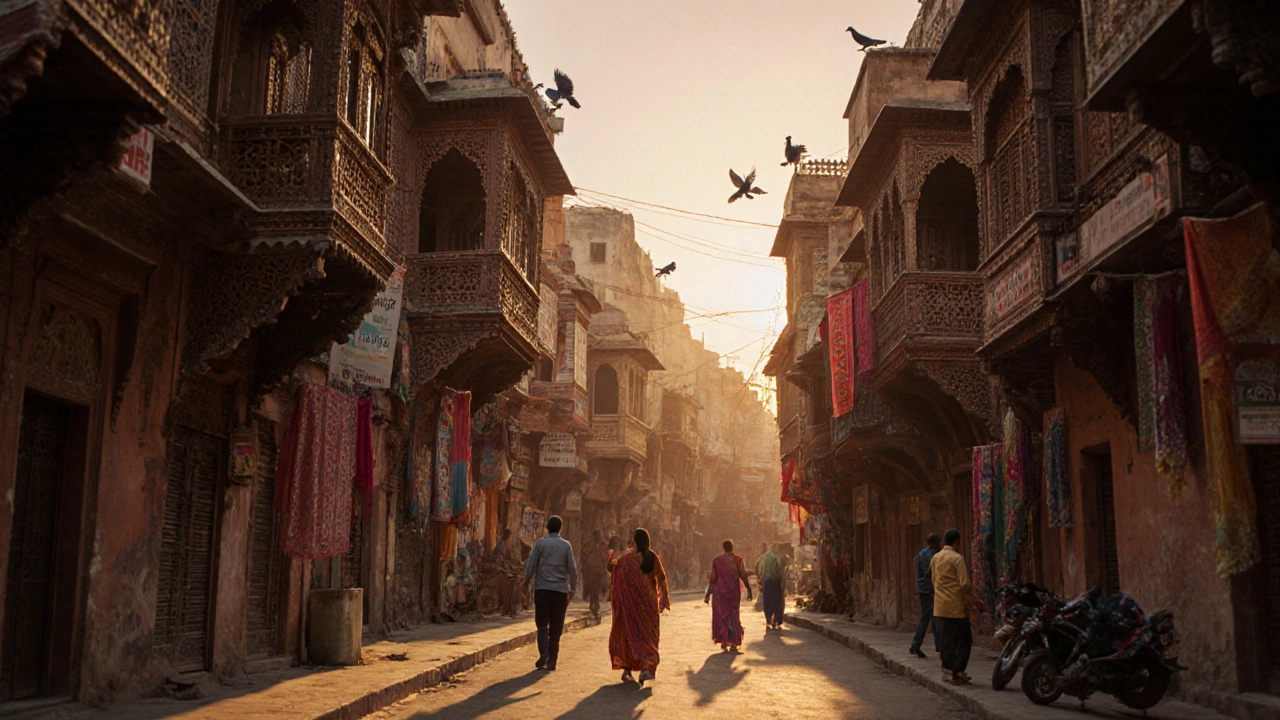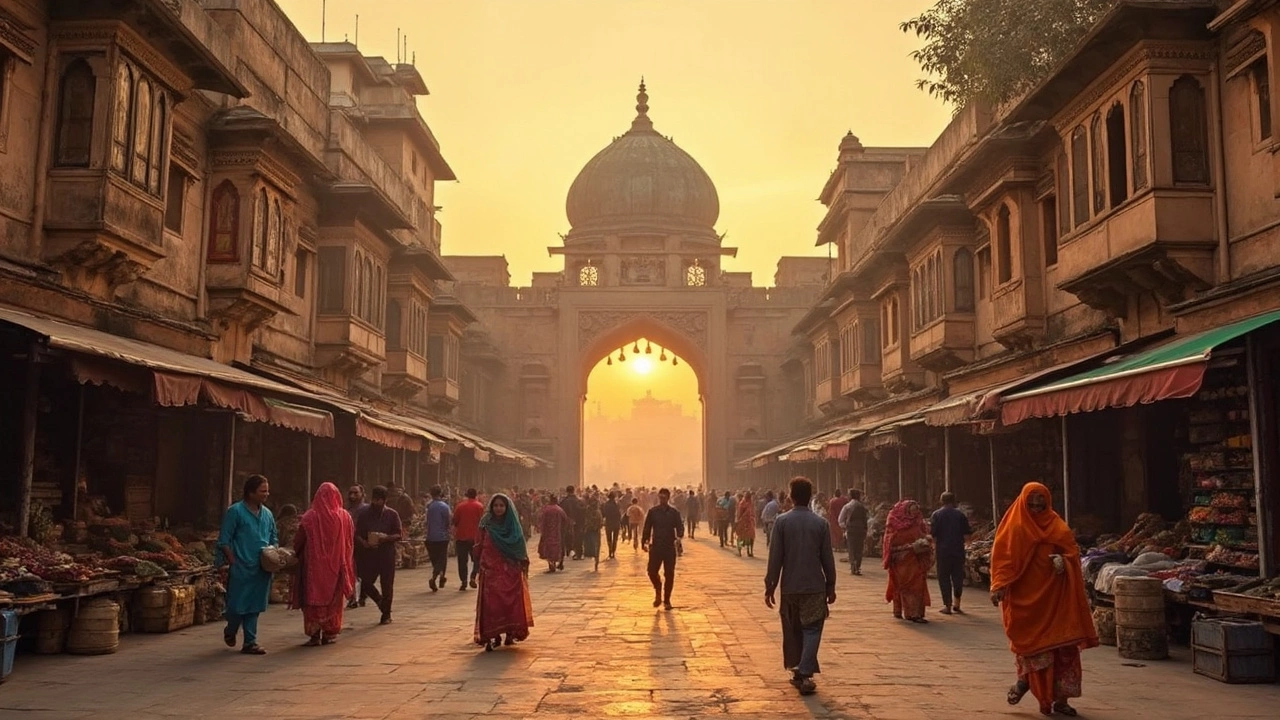Why is Ahmedabad so famous? Discover the heritage, culture, and history behind India’s UNESCO city

Ahmedabad Travel Climate Calculator
Climate Guide
Best season: October to March (18°C - 30°C)
Avoid: April to June (up to 45°C)
Events: International Kite Festival (January)
Ahmedabad isn’t just another city in Gujarat. It’s a living museum where Mughal mosques stand beside 20th-century bungalows, and centuries-old stepwells still hold water after 500 years. In 2017, it became India’s first city to earn UNESCO World Heritage status-not for one monument, but for the whole urban fabric. That’s rare. Most UNESCO sites are temples or palaces. Ahmedabad’s recognition came because its streets, homes, and public spaces tell a continuous story of trade, tolerance, and transformation.
The Walled City: A Maze of History
Walk through the old walled city, and you’re stepping into a 600-year-old urban plan that still works. Narrow lanes twist between havelis with carved wooden balconies, jharokhas that catch the breeze, and chabutras where pigeons gather at dawn. These aren’t restored showpieces-they’re homes. Families live in them. Shops open in their courtyards. The architecture isn’t frozen in time; it’s adapted.
The pol system is what makes this place unique. Each pol is a self-contained neighborhood, built around a shared well, temple, or community kitchen. They were designed by merchants in the 15th and 16th centuries to protect their families and businesses. Every pol had its own rules, its own gate, its own identity. Today, over 100 pols still exist. Some are fading. Others are being revived by young designers and local NGOs. But they’re still alive.
Sabarmati Ashram: Where Gandhi Changed the World
Just a few kilometers from the walled city, along the Sabarmati River, lies the ashram where Mahatma Gandhi lived for 12 years. It’s not grand. No marble, no gold leaf. Just simple stone buildings, a spinning wheel, and a small library. This is where he launched the Salt March in 1930-a 400-kilometer walk that shook the British Empire. The ashram isn’t a monument to a hero. It’s a reminder of how ordinary people, acting together, can change history.
Visitors walk the same path Gandhi did. They sit on the same floor where he wrote letters to world leaders. They spin cotton on the same charkha he used daily. The ashram doesn’t just preserve history-it invites you to feel it. Over 200,000 people visit every year. Many come just to sit quietly. To remember.
Adalaj Stepwell: Engineering That Feels Like Art
Most stepwells in India are ruins. Adalaj is different. Built in 1499 by Queen Rudabai, it’s a five-story underground masterpiece. Carved stone pillars hold up a ceiling that opens to the sky. Intricate carvings of gods, dancers, and animals line the walls. It’s not just a water source-it’s a temple, a resting place, a social hub.
Stepwells like this were engineering marvels in a land with long dry seasons. They lowered the water table by digging deep, then used the cool, shaded steps to let people access water without climbing. Adalaj’s design also cooled the air. In summer, temperatures inside drop by 5-6°C compared to outside. That’s passive cooling, 500 years before air conditioning.
Today, it’s one of the most photographed sites in Gujarat. But it’s not just for tourists. Locals still come to sit in its shade. Children play near its edges. It’s not a relic. It’s still part of daily life.

Religious Harmony in Stone and Prayer
Ahmedabad’s skyline is shaped by more than one faith. The Jami Masjid, built in 1424, looks like a mosque but has Hindu-style pillars and carved lotus motifs. The Sidi Saiyyed Mosque, with its famous stone latticework, is often called the “Taj Mahal of Gujarat.” Yet just a few streets away, you’ll find the 18th-century Jain temple of Nageshwar, its ceiling covered in gold leaf and tiny mirrors.
There’s no single dominant religion here. For centuries, Muslim rulers, Hindu merchants, Jain traders, and Parsee bankers lived side by side. They traded, married, and built together. The city’s architecture reflects that. You’ll see Islamic arches with Hindu carvings. Jain temples with Mughal domes. It’s not fusion-it’s coexistence made visible.
Textiles, Trade, and the Birth of Modern India
Ahmedabad was once called the “Manchester of India.” In the 19th century, it became the center of India’s cotton industry. Over 100 textile mills lined the Sabarmati River. Workers from all over Gujarat came to work in them. The mills didn’t just make cloth-they created a new middle class. They gave rise to labor unions, newspapers, and political movements.
Today, the old mills are gone. Many became warehouses. Some turned into design studios. But the spirit remains. The city still produces 70% of India’s cotton fabric. You can still find hand-block printers in the old quarter, using wooden blocks carved by hand. Their patterns-floral, geometric, animal-have changed little since the 1700s.

Why It Matters Today
Ahmedabad isn’t famous because it has one big attraction. It’s famous because it’s real. You don’t come here to check off a list. You come to feel how history lives in everyday moments. A woman draws water from Adalaj Stepwell. A child spins thread at Sabarmati Ashram. A family eats dinner in a 400-year-old pol. These aren’t performances. They’re routines.
That’s why UNESCO chose it. Not for its monuments, but for its continuity. In a world where cities are being torn down and rebuilt, Ahmedabad holds on. It doesn’t pretend to be something it’s not. It doesn’t erase its past to make room for glass towers. It lets them coexist.
If you want to understand India beyond the Taj Mahal or the Himalayas, come here. Walk the narrow lanes. Sit in the shade of a stepwell. Watch the sun set over the Sabarmati. You’ll see why this city still matters.
Is Ahmedabad worth visiting for history lovers?
Yes, absolutely. Ahmedabad offers one of India’s richest collections of living heritage. Unlike many historical sites that are preserved behind fences, here you walk through centuries-old neighborhoods, meet families who’ve lived in the same havelis for generations, and see functional stepwells and mosques that are still part of daily life. It’s not a museum-it’s a city that remembers.
How many days do you need to explore Ahmedabad properly?
Three days is ideal. Day one for the Walled City and pols, day two for Sabarmati Ashram and the nearby Kankaria Lake, and day three for Adalaj Stepwell and the textile markets. If you’re short on time, two days will cover the highlights, but you’ll miss the quiet moments-the early morning calls to prayer, the smell of fresh dhokla from a pol kitchen, the sound of water dripping in the stepwell.
Is Ahmedabad safe for solo travelers?
Very. Ahmedabad has one of India’s lowest crime rates among major cities. The streets are well-lit, locals are helpful, and the city is walkable. Solo travelers, especially women, often feel more comfortable here than in bigger cities like Delhi or Mumbai. Just stick to the main areas-Walled City, Ashram, and the riverside-and you’ll be fine.
What’s the best time of year to visit Ahmedabad?
October to March is perfect. Temperatures hover between 18°C and 30°C, making walking comfortable. The winter months also bring cultural events like the International Kite Festival in January, where the sky fills with colorful kites from around the world. Avoid April to June-temperatures can hit 45°C, and the heat makes exploring hard.
Can you visit Ahmedabad on a budget?
Easily. Entry to Sabarmati Ashram and most heritage sites is free or under ₹50. Local food-think dhokla, fafda, and jalebi-costs less than ₹100 a meal. Budget guesthouses in the Walled City start at ₹800 a night. Public transport is cheap, and walking is the best way to see the city. You don’t need luxury to experience its soul.
What makes Ahmedabad different from other heritage cities in India?
Most heritage cities in India are defined by one or two grand monuments-like Jaipur’s palaces or Varanasi’s ghats. Ahmedabad is different because its heritage isn’t concentrated. It’s spread across hundreds of buildings, streets, and community spaces. There’s no single ticket to buy. You don’t need a guide. You just walk, watch, and listen. The history isn’t curated-it’s lived.
What to See Next
If Ahmedabad hooked you, consider exploring nearby heritage spots. The Rani ki Vav stepwell in Patan is even older and more ornate. The Champaner-Pavagadh Archaeological Park, a UNESCO site just 50 kilometers away, has forgotten forts and ancient temples. Or head to the Kutch region, where handwoven textiles and desert crafts keep traditions alive.
Ahmedabad doesn’t end at its borders. It’s a gateway to a deeper India-one where history isn’t locked away, but worn like a familiar shirt, day after day.
